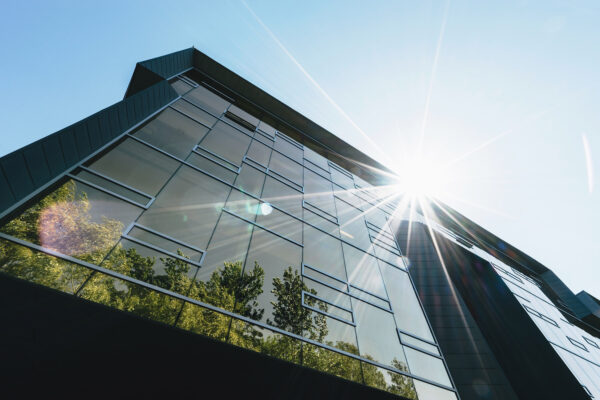Mind the Gap – The future of data centre circular energy systems and district heating
Every industry has its “north star”. A place we are all striving to get to or at least where an imagined utopia lies. For the financial markets it’s cryptocurrency, for automotive it’s the move to electric & autonomous vehicles & for the Data Centre Industry it has to be district heating/ waste heat re-use.

You don’t have to be a Greenpeace activist to worry about the path we are currently on as a planet. As a father, keen follower of corporate commitments and someone that wants to leave the world in a better place than I found it, working in the data centre industry has its moral challenges as we continue to take a larger share of natural resources. The topic of waste has always piqued my interest when spoken about on the conference circuit and as someone who wants to play an active rather than passive role, I felt it was time to throw in my two cents.
The figures around data consumption are certainly astonishing, however true or not. By 2025 we could expect that 3-5% of the worlds energy will be fuelling our drive for digitisation. The industry growth is by no means a bad thing. We have allowed people to work from the ends of the earth and still be able to contribute to critical processes. We can work and collaborate across time-zones comfortably and have reduced commuting to a point where even the London Underground had to reduce their ticket prices & worry about customer satisfaction.
However, with all this being said, there is one thing that keeps on coming up for all the right reasons – efficiency. Of course, there is a drive towards more efficient and intelligent data centres. My time spent looking at legacy sites on a regular basis has shown me that the industry has come a long way. I have seen a shift from data centres that operate (happily) on >2.5PUE & using vast amount of water, to requirements that drive us to design solutions below >1.25 more and more with zero / limited water use. And all this is happening while supply air temperatures remain relatively unchanged in recent years, yet requirements around ambient conditions have become more and more stringent.
To some degree we can all pat ourselves on the back that technology and the drive and collaboration of the entire value-chain has pushed PUE and WUE a point of maturity, where we are pushing for incremental gains now rather than wholesale improvements, with very finely tuned systems operating at peak performance. However, while we are all busily chipping away on the 0.25 (or less), who is working on the ONE?
Greening the supply of electricity into a data centre is certainly a great intermediate step and most operators are promoting their green credentials via renewable power purchase agreements (PPAs). It makes great headlines, but the grid isn’t being re-wired and on a calm night, where do you think all this power is coming from? The key to eating into the 1 is a circular economy, where a waste product of one process can be used to feed another. PPAs haven’t delayed the need to achieve this….we all should be looking at waste re-use, sooner rather than later.
Let us consider initiatives like the Climate Neutral Data Centre Pact. There are some great goals set out by this group, mainly targeting energy efficiency and pushing suppliers like Airedale to the limit in developing technologies that can meet the challenging PUEs of the future. As a manufacturer, we can comfortably say that chillers have come a long way in the last few years. As data centre parameters evolved, chiller technology was put under pressure to remain relevant, but with on-going R&D investment, , we maintained pace. Our high-efficiency, free cooling chillers operate on approach temperatures of 5-6K in full load, meaning that with a well-controlled internal close control system, best-in-class PUEs are within reach, without the use of water spray, even in challenging climates.
The climate pact doesn’t stop there; there are some essential goals around the reduction of water usage and the use of clean energy, and what I feel is the most important point, ‘Circular Energy Systems.’ he re-use of data centre heat is presenting not just a challenge, but is also an opportunity for companies to differentiate themselves versus the competition in the sector, and other industries.
This brings me to ‘District Heating’ – another one of those terms that has been used in this industry more often than I can remember, by myself included. Positioning a data centre near a heat customer is an often cited challenge…it would be great to find a site with electricity / fibre headroom in a location where the surroundings are perfectly poised to use low grade heat to warm high-rise flats, swimming pools and vertical farms. However, there is clearly more than just a scope gap between the local council office and high-tech technology company running at the sharp end of capitalism. That is by no means a criticism of local councils who work tirelessly to shape our neighbourhoods, but clearly we all have to be realistic on what is achievable in a world not designed with data centres in mind. The utopia of waste heat being fed into district heating schemes, warming the homes of communities somehow located immediately next door to the friendly neighbourhood data centre, is a pipe dream in many of Europe’s data centre growth hubs. It is more realistic to look at industries like vertical farming, especially in an era of such economic and political uncertainty. Industries like this need to be stimulated and brought to the table by Government and planning departments. Joined up thinking around location of industries is the true key to unlocking all this potential.
The industry is doing a great thing by announcing that Europe’s top data centre providers are committing to exceeding the goal of the European Union to be Net Zero by 2050. However, if the industry is to be net zero by 2030 as pledged, we need more government action to engage with operators, technology companies like Airedale and our local bodies, to shape the cooling & heat re-use systems that will need to be deployed to deliver a fully circular economy. Commitments to offset high energy footprint by playing the power markets is just not good enough.
So with all this being said and given the title of this blog, what gap are we trying to mind here? Where are we at highest risk of slipping into the scope gap between the data centre and possible beneficiary of the waste heat? The answer to that is quite simple; The golden coin of the bottom of the well needs to be reachable so that someone can turn a profit connecting the two. This can be initially achieved via local funding but eventually the entire value chain needs to independently bridge the gap from red to black on the year-end statement. On-top of that, data centre providers need to future-proof facilities and allow the design of the heat rejection systems to include for tap-off points that can be utilised when the local authority when the heat customer is ready.
As always, there is certainly not a silver bullet. However, hearing what everyone has to say across all the data centre media platforms, it is fabulous to see how the entire industry is working hard towards Net Zero and I am confident it will eventually bridge the gap and bring the data centre into the local community & help create a true circular economy.
I am excited to be a part of it – onwards and upwards. Let’s just mind the gap.
 Daniel Burczyk
Daniel Burczyk
Business Development Manager – Data Centres





